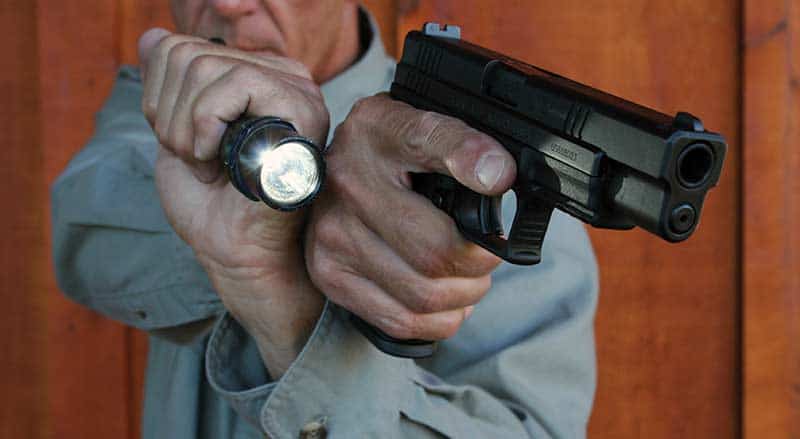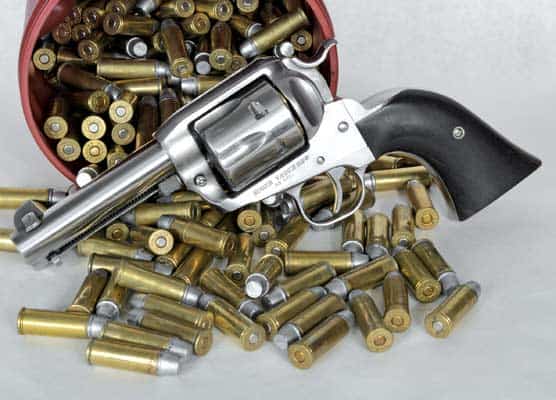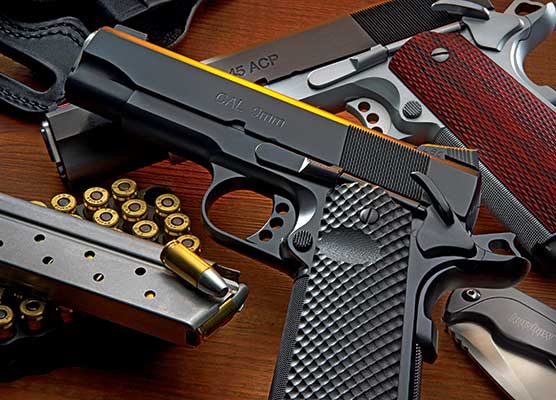The Tactics Of Light
White light technology has made quantum leaps during the last decade. We shouldn’t shoot at what we can’t identify and much of what cops and even civilians do is often done in altered light environments. So like it or not some understanding of application and a level of skill in deployment is required.
I see a lot of people use the flashlight in the German air raid over London technique with the beam going in all sorts of directions including at people. That in and of itself isn’t bad but when applied to weapons mounted lights it deteriorates into something really ugly. So, a review of the why, when and how of white light use might bear merit.
Why
Why is pretty simple. A white light might be needed to solve a visual problem. Please note I said needed. I didn’t say wanted. If I asked who wants to turn on a light in the middle of a gunfight, the number of takers should be pretty slim. If I asked who might need to turn on a light in a gunfight, the numbers should increase — simple answer, it’s very hard to hit something you can’t see. To hit the threat you need to use the sights or a laser thing. That’s what will actually place the projectile on target. You’re not shooting them with the light, you’re just making sure what you are about to shoot is what you want or need to shoot.
When
White light should help identify the target you’re about to engage. The officer’s light may impede or impair the threat’s ability to see or shoot back. But, light in the threat’s eyes won’t keep their finger from pulling a trigger and sending a round towards your light source. So when do you use the light?
Use it as little as possible so as not draw attention — common sense. If you have multiple suspects and you engage and down a threat, standing there with the light on the downed threat makes you a target.
Remember, once you turn on a modern hand torch, threats rooms away pretty much know you’re present. Could they shoot at you thru the walls? Yes, I guess they could. But, I’m pretty sure you shouldn’t shoot back through the walls without confirming the threat, possible bystander or hostage being present.
A very rare commodity should be added to the mix — common sense. I’m pretty sure it’s better to see what the hell is going on in front of you than wandering around in the dark. Yeah, yeah, yeah, “we own the night,” so if you like fighting in the dark you’re welcome to my share. Is the light being on dangerous? Can the light draw fire? Yes and yes, then again your options are wander in the dark and engage threats without confirmation of weapons and or hostages or turn the light on to see and act accordingly.
Crossover
There’s a big bleed-over now in military and police training with techniques and weapons seemingly crossing back and forth. Cops should remember they’re cops first and train for issues needing to be addressed within their occupation. Concerns might be officer safety, public safety, confirmation of threats and weapons, verbal compliance requests and some other subtle cop issues. Trust me if I thought we could blow the building up with an air strike and if we had a “tactical illumination tool” that burned the eyeballs from the threat’s sockets, I’d vote for it every time if it kept even one cop from losing their life. Problem is, the air strike and eyeball burner outer light might run into some problems with the lawyers, not to mention, the public’s perspective of conflict resolution.
Light Technology
Go into a dark room and turn on a flashlight. There are actually two lights; the light comprising the main beam or spot and then the large illuminated area or corona. We train — hopefully — to work our eyes and bust out of intense focus or tunnel vision to be aware of other threats. We do this knowing our eyes will be drawn to the threat and often the weapon. Train to look at the spot or beam of light. Keep it parallel to the weapon’s muzzle. But also be aware of and visually search the area illuminated by the corona projected by the flashlight.
Hand Held Techniques
Four basic techniques should be considered by anyone using a flashlight. This doesn’t mean there aren’t others — it’s simply a starting point.
Crossed is exactly that; simply cross the wrists so they lay back to back on each other. It might remind you of trying to hold your watch crystal in place while firing.
Uncrossed is also what it says, it’s best done by keeping the thumbs in contact so as to not have the fingers of the light hand interfere with the slide while firing. It also solves the problem of the light placement on clearing right hand corners by having the light lead first.
Syringe is the placement of the light between the first and second fingers while using the base of the thumb and palm as the pressure point to activate the light. Thumbs together on this one also.
Syringe supported depends on the size of your hands. The two or three lower fingers of the light hand are extended and wrap around the strong hand fingers that are holding the pistol.
All are, in fact, one-handed firing. That said, the light support hand is placed to support the handgun while being fired as much as possible.
Retention
There are good and bad ways of controlling the light, but any retention system is better than shoving the light in your pocket. The idea is to control the light, be able to fire and perform the manipulations of loading, reloading and malfunction clearances.
String lanyards are good if they fit correctly. Ditch the plastic keepers and tabs. Then stacking flat hands one over the other and allowing the light to just clear your hands, all extra lanyard material off and burn and crush the ends. It keeps the thing out of magazine wells and ejection ports.
A ring works well by simply rolling it over the back of the hand or into the palm. I think it’s best used on the index finger. By simply rolling the light out of the way to the back of the hand all manipulations can be accomplished easily.
I’ve been exposed to straps and personally haven’t figured it out yet — slow witted I guess — but I am working on it.
Gun Mounted
If the cop running the gun understands how to use the system, weapon mounted lights can be a good choice. I mentioned the spot of light correlated to the muzzle and the corona projected by the light system. If you use the corona to search and or confront possible suspects there should be no issues. However, a lack of understanding techniques for deployment can result in muzzle winding up being in the wrong place. Add incorrect placement of the finger on the trigger and quite a rodeo begins that will be painful to all involved parties.
Fighting Words?
The knowledgeable already know the vast majority of cops are under trained with firearms, so I think the same thing can be said about lighting systems — hand held or gun mounted. There must be a sincere effort to improve firearms and illumination training. Before you want to kick me in the crotch for saying that, ask yourself how many people in your department would you trust behind you with a loaded gun in a fight? Now what about in the dark?
Whose Who
ASP’s two-battery three-bulb light is outstanding light, although I don’t get the strap thing. Streamlight’s version the TL-2 LED is also an excellent light and rumor has it, upcoming improvements in the tail cap and bulbs will make it better.
SureFire’s new G2 LED with a polymer body is a super hand held and probably the best priced of the three. Any of these choices would make a more than serviceable hand held light.
Handgun Gun Mounted
The Streamlight TLR-2 is a solidly made strong light whose only shortcoming might be the screw on the side attachment system as far as ease of off and on. Then again if carried weapon mounted in a holster, it makes little difference and it’s priced very well too.
SureFire’s X200 A&B models are both rock solid contenders for a place on your pistol, but their replacement, the new X300, is pure magic as you’d expect from SureFire.
Acquire And Train
Get a handheld and gun mounted light and train with them both. Do so in the daylight in the beginning to acquire skills and then transfer the manipulation skills you learn to altered light training environments.
Consider the concept of not over engineering the use of the light and better yet, practice fundamental applications. Fundamentals have been known to contribute significantly to winning fights. Without question, this knowledge is another skill for a cop’s need to know toolbox.
For More Info:
www.asp-usa.com
www.streamlight.com
www.surefire.com
Subscribe To American Handgunner

Get More Personal Defense Tips!
Sign up for the Personal Defense newsletter here:









